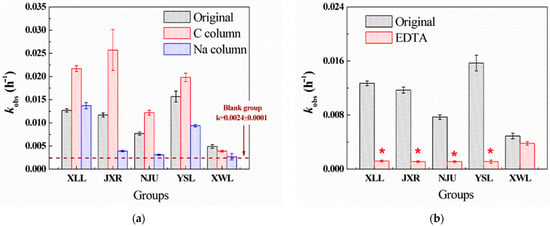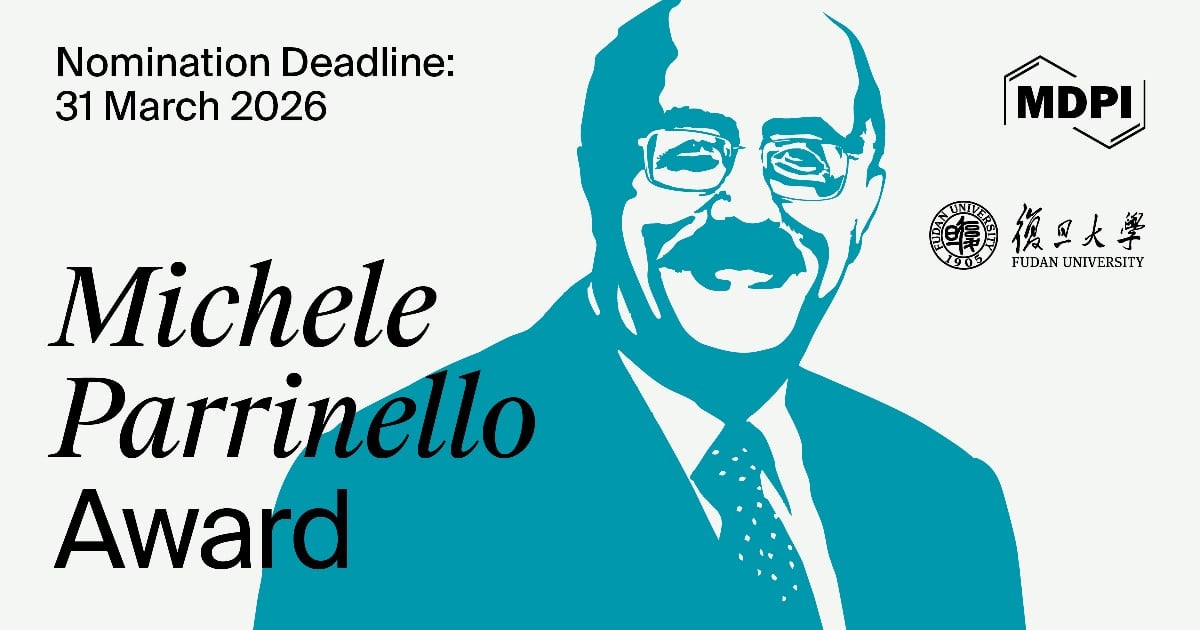-
 Antibiotic Elution from Cement Spacers and Its Influencing Factors
Antibiotic Elution from Cement Spacers and Its Influencing Factors -
 Greek Essential Oils Against Resistant E. coli and O157:H7
Greek Essential Oils Against Resistant E. coli and O157:H7 -
 Targeting Bacterial Biofilms on Medical Implants: Current and Emerging Approaches
Targeting Bacterial Biofilms on Medical Implants: Current and Emerging Approaches -
 Evaluating Antimicrobial Susceptibility Testing Methods for Cefiderocol: A Review and Expert Opinion on Current Practices and Future Directions
Evaluating Antimicrobial Susceptibility Testing Methods for Cefiderocol: A Review and Expert Opinion on Current Practices and Future Directions
Journal Description
Antibiotics
Antibiotics
is an international, peer-reviewed, open access journal on all aspects of antibiotics, published monthly online by MDPI. The Croatian Pharmacological Society (CPS) is affiliated with Antibiotics and its members receive discounts on the article processing charges.
- Open Access— free for readers, with article processing charges (APC) paid by authors or their institutions.
- High Visibility: indexed within Scopus, SCIE (Web of Science), PubMed, PMC, Embase, CAPlus / SciFinder, and other databases.
- Journal Rank: JCR - Q1 (Infectious Diseases) / CiteScore - Q1 (General Pharmacology, Toxicology and Pharmaceutics )
- Rapid Publication: manuscripts are peer-reviewed and a first decision is provided to authors approximately 15 days after submission; acceptance to publication is undertaken in 2.6 days (median values for papers published in this journal in the first half of 2025).
- Recognition of Reviewers: reviewers who provide timely, thorough peer-review reports receive vouchers entitling them to a discount on the APC of their next publication in any MDPI journal, in appreciation of the work done.
Impact Factor:
4.6 (2024);
5-Year Impact Factor:
4.9 (2024)
Latest Articles
The Domination of Penicillin G Degradation in Natural Surface Water: Effect of Calcium Ion and Biological Dissolved Organic Matter
Antibiotics 2025, 14(11), 1144; https://doi.org/10.3390/antibiotics14111144 - 11 Nov 2025
Abstract
►
Show Figures
Background: Although hydrolysis and photolysis are important pathways for penicillin antibiotics degradation in aquatic ecosystems, the degradation mechanism of penicillin antibiotics in real natural waters is rarely reported. Furthermore, the dominant factors influencing this process are poorly understood. Methods: Therefore, five natural waters
[...] Read more.
Background: Although hydrolysis and photolysis are important pathways for penicillin antibiotics degradation in aquatic ecosystems, the degradation mechanism of penicillin antibiotics in real natural waters is rarely reported. Furthermore, the dominant factors influencing this process are poorly understood. Methods: Therefore, five natural waters were selected to simulate both the hydrolysis and photolysis processes of penicillin G (PG) in aqueous environments. Results: Our results demonstrated that the half-life of PG hydrolysis ranged from 44 h to 141 h in natural water, and aqueous Ca2+ ion was the most important factor controlling the hydrolytic degradation of PG. Moreover, several biological dissolved organic matter (DOM, microbial by-product compounds) could also promote the PG hydrolysis reaction. Direct photolysis of PG is dominated in natural water, for which half-life photodegradation rates were 6 h in both blank and natural water, suggesting that salinity and DOM have little influence on penicillin photolysis. The hydrolysis reaction mainly involved the cleavage of the ester bond in the β-lactam ring and a decarboxylation process, while photolysis degradation principally included the hydroxylation of the benzene ring and destruction of the thiazole ring. Conclusions: This study demonstrates the significant factors influencing hydrolysis and photolysis of penicillin antibiotics in an aquatic ecosystem, which can improve the estimates of ecological risk of antibiotic pharmaceuticals in a realistic environment.
Full article
Open AccessArticle
Phylogenomics and Antimicrobial Resistance of Clinical Bacteroides Isolates from a Tertiary Hospital in Southern Thailand
by
Mingkwan Yingkajorn, Thunchanok Yaikhan, Worawut Duangsi-Ngoen, Chollachai Klaysubun, Thitaporn Dechathai, Sarunyou Chusri, Kamonnut Singkhamanan, Rattanaruji Pomwised, Monwadee Wonglapsuwan and Komwit Surachat
Antibiotics 2025, 14(11), 1143; https://doi.org/10.3390/antibiotics14111143 - 11 Nov 2025
Abstract
►▼
Show Figures
Background/Objectives: Bacteroides species are key members of the human gut microbiota but can act as opportunistic pathogens. This study investigated the genomic features of clinical Bacteroides isolates from southern Thailand. Methods: Sixteen isolates were collected from body fluids, tissues, and pus
[...] Read more.
Background/Objectives: Bacteroides species are key members of the human gut microbiota but can act as opportunistic pathogens. This study investigated the genomic features of clinical Bacteroides isolates from southern Thailand. Methods: Sixteen isolates were collected from body fluids, tissues, and pus at Songklanagarind Hospital (2022–2024). Whole-genome sequencing was performed on the BGI platform, followed by genome assembly, annotation, average nucleotide identity (ANI), pairwise single-nucleotide polymorphism (SNP) analysis, antimicrobial resistance (AMR) gene profiling, plasmid prediction, virulence screening, and phylogenetic analysis. Results: ANI and SNP analysis revealed two clusters: one comprising B. ovatus, B. intestinigallinarum, and B. thetaiotaomicron, and another mainly B. fragilis with one B. hominis isolate. All isolates were resistant to ampicillin, cephalothin, and penicillin; six B. fragilis strains were resistant to all tested antibiotics. The β-lactamase gene cepA was detected in all B. fragilis isolates, and plasmids were predicted in two genomes. Three virulence types (capsule formation, lipopolysaccharide modification, and stress response) were identified. Phylogenomic analysis confirmed species-level assignments and revealed underrecognized lineages, emphasizing the value of genome-based approaches for accurate classification. Conclusions: Clinical Bacteroides isolates display diverse resistance and virulence profiles, highlighting the importance of strain-level genomic surveillance.
Full article
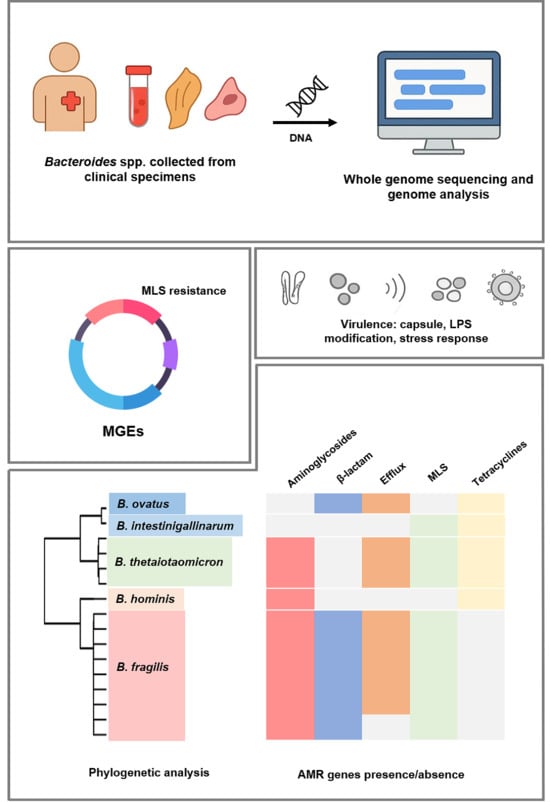
Graphical abstract
Open AccessArticle
Bacterial Profile and Antibiotic Resistance of ESKAPEE Pathogens Isolated in Intensive Care Units from Blood Cultures: A Cross-Sectional Study from Abu Dhabi, United Arab Emirates (2018–2022)
by
Ayesha Abdulla Al Marzooqi, Maryam Mohammed Bashir, Mohammed Ahmed Khogali, Abubaker Suliman, Collins Timire, Farida Ismail Al Hosani and Faisal Musleh Al Ahbabi
Antibiotics 2025, 14(11), 1142; https://doi.org/10.3390/antibiotics14111142 - 11 Nov 2025
Abstract
Background: Antibiotic resistance is a significant health problem in healthcare settings, especially intensive care units (ICUs), where patients are critically ill. This study aims to identify the bacterial profile and antibiotic resistance patterns of Enterococcus faecium, Staphylococcus aureus, Klebsiella pneumoniae,
[...] Read more.
Background: Antibiotic resistance is a significant health problem in healthcare settings, especially intensive care units (ICUs), where patients are critically ill. This study aims to identify the bacterial profile and antibiotic resistance patterns of Enterococcus faecium, Staphylococcus aureus, Klebsiella pneumoniae, Acinetobacter baumannii, Pseudomonas aeruginosa, Enterobacter, and Escherichia coli (ESKAPEE) in blood specimens collected from adult patients admitted to the ICUs of public hospitals in Abu Dhabi, United Arab Emirates. The World Health Organization lists these pathogens as priority pathogens that greatly threaten humans. Methods: This cross-sectional study used routinely collected data through the AMR surveillance system between 2018 and 2022. Results: A total of 838 culture-positive blood specimens were reported during the study period, and 965 ESKAPEE pathogens were isolated. The most frequently isolated bacteria were Klebsiella pneumoniae (31%), Escherichia coli (22%), and Staphylococcus aureus (20%). Acinetobacter baumannii exhibited high resistance to Amikacin (81%), Meropenem (72%), and Imipenem (87%). Escherichia coli demonstrated resistance to Imipenem (42%) and Cefotaxime (54%). Klebsiella pneumoniae showed resistance to Imipenem (37%) and Cefotaxime (39%). Staphylococcus aureus showed resistance to Penicillin G (80%), Oxacillin (4%), and Ciprofloxacin (54%). Conclusions: The study showed a high prevalence of resistance in the most frequently isolated ESKAPEE pathogens in adult ICU patients. This brings into focus the need for appropriate infection control measures and strong antibiotic stewardship programs. The findings of the study support the ongoing efforts to deploy a better diagnostic tool for rapid pathogen identification, which is key in the targeted management of patients with bloodstream infection, especially in ICUs.
Full article
(This article belongs to the Section Antibiotics Use and Antimicrobial Stewardship)
►▼
Show Figures
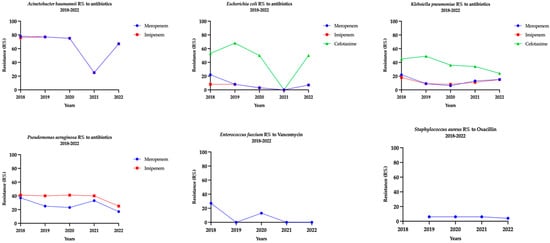
Figure 1
Open AccessArticle
Antimicrobial Use and Manure Management Among Pig and Poultry Farmers in Malawi
by
Amon Abraham, Andrew G. Mtewa, Chimwemwe Chiutula, Richard Lizwe Steven Mvula, Alfred Maluwa, Fasil Ejigu Eregno and John Njalam’mano
Antibiotics 2025, 14(11), 1141; https://doi.org/10.3390/antibiotics14111141 - 11 Nov 2025
Abstract
Background/objectives: Antimicrobial resistance (AMR) is a growing public health concern, and misuse of antibiotics in livestock farming contributes to its emergence. In Blantyre, Malawi, small-scale pig and poultry farming is widespread, but the knowledge, attitudes, and practices (KAP) driving antimicrobial use (AMU) remain
[...] Read more.
Background/objectives: Antimicrobial resistance (AMR) is a growing public health concern, and misuse of antibiotics in livestock farming contributes to its emergence. In Blantyre, Malawi, small-scale pig and poultry farming is widespread, but the knowledge, attitudes, and practices (KAP) driving antimicrobial use (AMU) remain poorly understood. This study aimed to assess the KAP regarding AMU and manure management among pig and poultry farmers in Blantyre, Malawi. Methods: This cross-sectional study surveyed 118 randomly selected farmers to assess AMU patterns, sources of antibiotics, adherence to withdrawal periods, disposal practices, and awareness of AMR and regulations. Data was collected using a structured questionnaire and analyzed with descriptive statistics and inferential tests (with statistical significance set at p < 0.05). Results: Antibiotic use was reported by 88% of farmers, primarily for therapy (93.3%) and prophylaxis (85.6%), including for viral diseases such as Newcastle disease in poultry and African swine fever in pigs. Oxytetracycline (91.5%), penicillin (50.8%), and trimethoprim-sulfamethoxazole (39.8%) were the most used antibiotics, predominantly sourced from agrovet shops (73.7%). While 61% of farmers knew antibiotic misuse could lead to AMR, significant gaps were observed: 68.6% had no formal training, 55.9% were unaware of regulations, and 42% sold/consumed products before the end of the withdrawal period. Most farmers disposed of expired antibiotics (80.5%) and packaging (92.4%) in household waste. Higher education and prior training were significantly associated with good knowledge. Conclusions: This study reveals significant knowledge–practice gaps and high-risk behaviors, such as misuse for viral diseases and unsafe disposal, that exacerbate AMR risks. Interventions must prioritize targeted farmer education, strengthening of veterinary extension services, and stricter regulation of agrovet shops to promote antimicrobial stewardship and support Malawi’s National Action Plan on AMR.
Full article
(This article belongs to the Special Issue Antimicrobial Resistance and Infections in Animals)
►▼
Show Figures
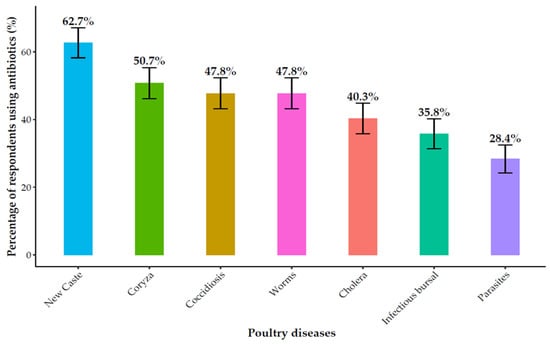
Figure 1
Open AccessArticle
Widespread Distribution of Carbapenem-Resistant Klebsiella spp. in Clinical and Environmental Settings
by
Karla Vanessa Molina Maldonado, Julia Marchese Pereira, Tamires Nascimento da Costa, Gabriel Lemos Buss, Kethlen Natiele de Almeida Pereira, Anelise Baptista da Silva, Gertrudes Corção, Ândrea Celestino de Souza, Amanda Silva Martins, Diego Rodrigues Falci, Ariane Baptista Monteiro, Claudia Flores, Kayo Bianco, Maysa Mandetta Clementino, Carlos Alexandre Sanchez Ferreira, Renata Medina-Silva and Sílvia Dias de Oliveira
Antibiotics 2025, 14(11), 1140; https://doi.org/10.3390/antibiotics14111140 - 10 Nov 2025
Abstract
►▼
Show Figures
Background/Objectives: Klebsiella spp., particularly K. pneumoniae, are major opportunistic pathogens in healthcare settings driven by carbapenemase- and ESBL-producing strains. We assessed antimicrobial resistance and biofilm formation abilities in Klebsiella spp. from a Brazilian tertiary hospital and related environments and characterized
[...] Read more.
Background/Objectives: Klebsiella spp., particularly K. pneumoniae, are major opportunistic pathogens in healthcare settings driven by carbapenemase- and ESBL-producing strains. We assessed antimicrobial resistance and biofilm formation abilities in Klebsiella spp. from a Brazilian tertiary hospital and related environments and characterized capsular types. Methods: Over six months (July–December 2023), 303 carbapenem-resistant Klebsiella spp. were collected from clinical specimens (n = 198), ICU/non-ICU surfaces (n = 79), hospital sewage (n = 22), and stream water (n = 4). Species were identified by MALDI-TOF. Susceptibility testing covered eight antibiotic classes, focusing on carbapenems and polymyxin B. Biofilm formation was quantified by crystal violet, and capsular typing used wzi/K-locus approaches. Results: Most isolates (70.95%) had meropenem MICs ≥ 128 μg/mL, while 77.6% (n = 235) remained susceptible to polymyxin B. Resistance profiles largely consisted of extensive drug resistance (95.4%), with 1.3% exhibiting pandrug resistance, including isolates from bed rails. Biofilm formation was detected in 96.7% of isolates, mainly weak (67.6%) or moderate (28%), with 4.4% being strong producers. Among the Klebsiella isolates analyzed, 21 K types were identified with an uneven distribution dominated by K64, followed by K24, K173, and K50. K75 was the only K type detected across all sources—clinical isolates, bed-rail surfaces (non-ICU), wastewater, and fluvial water. Conclusions: Carbapenem-resistant Klebsiella spp. exhibited widespread resistance, with residual susceptibility to aminoglycosides, ceftazidime–avibactam, and polymyxins. Environmental reservoirs—hospital surfaces, sewage, and stream water—harbored resistant biofilm producers, reinforcing their role in persistence and dissemination. K-typing revealed concentrated distribution (predominantly K64) and cross-source K75. These findings underscore the urgency of integrated strategies combining molecular surveillance, antimicrobial stewardship, and environmental control.
Full article

Figure 1
Open AccessArticle
Shared Decision-Making in Veterinary Clinics: A Cross-Sectional Study Examining Effects on Appropriate Antibiotic Prescribing and Value-Driven Factors Influencing It
by
Huiling Guo, Lay See Ong, Zoe Jane-Lara Hildon, Timothy Chua, Boon Han Teo and Angela Chow
Antibiotics 2025, 14(11), 1139; https://doi.org/10.3390/antibiotics14111139 - 10 Nov 2025
Abstract
Background: Shared decision-making (SDM) can improve appropriate antibiotic prescribing in human primary care clinics, but little is known about it in the veterinary setting. This study examines the association between SDM and antibiotic prescribing for cats and dogs in veterinary clinics, then determines
[...] Read more.
Background: Shared decision-making (SDM) can improve appropriate antibiotic prescribing in human primary care clinics, but little is known about it in the veterinary setting. This study examines the association between SDM and antibiotic prescribing for cats and dogs in veterinary clinics, then determines the key factors influencing SDM through a value-driven approach. Methods: This cross-sectional study surveyed 41 veterinarians practicing in Singapore veterinary clinics. Appropriate antibiotic prescribing was defined as concordance with local antibiotic guidelines for companion animals, while an adapted SDM-Q-9-Doc scale measured SDM on antibiotic prescribing with pet owners. Questions were developed to measure constructs of the VALUE model and factor analysis was conducted to identify latent factors. Multivariable logistic and linear regressions were performed to assess the association between SDM and antibiotic prescribing, and determinants of SDM, respectively. Results: Antibiotics were most inappropriately prescribed for cats/dogs with ear infections (cocci observed) (63%), and periodontal disease (59%). Engaging owners in SDM (AOR 1.31; 95% CI 1.05, 1.62; p = 0.014) was positively associated with appropriate antibiotic prescribing for cats/dogs with periodontal disease. After adjusting for age, gender, clinic role and practice type, veterinarians with a higher overall VALUE score (β = 0.14; 95% CI 0.02, 0.26; p = 0.021) were more likely to engage in SDM with owners on antibiotic prescribing. Conclusions: SDM with pet owners improves appropriate antibiotic prescribing for cats and dogs, though effects vary by clinical scenario. Aligning AMR-related values between veterinary clinics and veterinarians to enable effective communication with pet owners can promote SDM and subsequently drive appropriate antibiotic prescribing for pet cats and dogs.
Full article
(This article belongs to the Special Issue Epidemiology, Impact and Mitigation of Antimicrobial Resistance in Veterinary Medicine, 3rd Edition)
►▼
Show Figures

Figure 1
Open AccessReview
Anti-Infective-Associated AKI: A Narrative Review of the Epidemiology, Mechanisms, Risk Factors, Biomarkers, Clinical Course, Monitoring, Prevention, and Therapeutic Strategies
by
Iman Karimzadeh, Sandra L. Kane-Gill and Binglei Ma
Antibiotics 2025, 14(11), 1138; https://doi.org/10.3390/antibiotics14111138 - 10 Nov 2025
Abstract
Acute kidney injury (AKI) occurs commonly in hospitalized patients, especially patients in intensive care units (ICUs). Medications are among the major causative factors of AKI. This narrative review addressed and updated different aspects of anti-infective-associated AKI, including amphotericin B, cidofovir, foscarnet, polymyxins, vancomycin,
[...] Read more.
Acute kidney injury (AKI) occurs commonly in hospitalized patients, especially patients in intensive care units (ICUs). Medications are among the major causative factors of AKI. This narrative review addressed and updated different aspects of anti-infective-associated AKI, including amphotericin B, cidofovir, foscarnet, polymyxins, vancomycin, and aminoglycosides. There is no standard definition or operational criteria to describe anti-infective-associated AKI. Characteristically, it usually occurs during the first two weeks of treatment and is typically dose dependent. Functional resolution occurs, but kidney injury can affect renal functional reserve and increase susceptibility to future AKI events. A variety of pathophysiological mechanisms impacting glomerular, tubular, and interstitial components of the kidney are usually responsible for the development of AKI from anti-infective medications. Oxidative stress and inflammation play a pivotal role in the pathogenesis of antibiotic-related AKI. Numerous patient-related, medication-related, and co-administered-related scenarios have been demonstrated as risk factors for anti-infective-induced AKI. Apart from traditional indexes of kidney function (serum creatinine and urine output), novel biomarkers of kidney function (e.g., serum cystatin C) and damage (e.g., urinary kidney-injury molecule-1 and neutrophil gelatinase-associated lipocalin) have been noticed in recent clinical studies with promising findings. The efficiency of preventive strategies against anti-infective-associated AKI in most cases appears to be variable, relative, and modest. Close and regular monitoring of kidney function parameters is crucial during treatment with nephrotoxic antibiotics. Currently, there is no definitive treatment modalities for the management of AKI with anti-infectives. Therefore, supportive care is the mainstay of treatment.
Full article
(This article belongs to the Section Pharmacokinetics and Pharmacodynamics of Drugs)
►▼
Show Figures

Figure 1
Open AccessArticle
Genomic Characterization of Multiple Antibiotic-Resistant Enterococcus in Farm Animals in Ningxia Province, China
by
Haoyu Zhao, Wen Zhang, Tianran Tang, Likun Zhang, Shengling Cui, Shengli Chen, Huafang Hao, Yating Deng, Weimin Zhang, Qi Yang, Zengqi Yang, Qian Shao and Juan Wang
Antibiotics 2025, 14(11), 1137; https://doi.org/10.3390/antibiotics14111137 - 10 Nov 2025
Abstract
Background/Objectives: In an era of increasing bacterial resistance, Enterococcus, as a reservoir of antibiotic resistance genes, poses a serious threat to public health. Methods: This study conducted antibiotic susceptibility tests, whole-genome sequencing, and bioinformatics analysis on 89 Enterococcus isolates from chickens, pigs,
[...] Read more.
Background/Objectives: In an era of increasing bacterial resistance, Enterococcus, as a reservoir of antibiotic resistance genes, poses a serious threat to public health. Methods: This study conducted antibiotic susceptibility tests, whole-genome sequencing, and bioinformatics analysis on 89 Enterococcus isolates from chickens, pigs, cattle, and sheep in Ningxia Autonomous Region. Results: The resistance rates of Enterococcus to clindamycin, cefoxitin, sulfamethoxazole, and tamoxifen were all above 95%, and 96.6% (86/89) of the isolates were multi-antibiotic resistant. There were significant differences in resistance phenotypes among different species, with Enterococcus from pigs showing significantly higher resistance than those from other animals. optrA was commonly found in Enterococcus from pigs, accounting for 61.5% (8/13). ST480, ST16, ST116, and ST300 were the main MLST types, and ST16 was one of the important pathogenic Enterococcus types. Conclusions: The study revealed the occurrence of inter-species transmission events of Enterococcus. In conclusion, this study comprehensively described the resistance spectrum, sequence characteristics, and transmission features of resistance genes in Enterococcus isolated from farm animals, and emphasized the possibility of the spread of resistance genes carried by Enterococcus from farm animals to humans.
Full article
(This article belongs to the Special Issue A Themed Issue in Honor of Professor Stefan Schwarz—Antimicrobial Resistance of Bacteria of Animal Origin: Diagnostics, Monitoring, Mechanisms and Epidemiology)
►▼
Show Figures
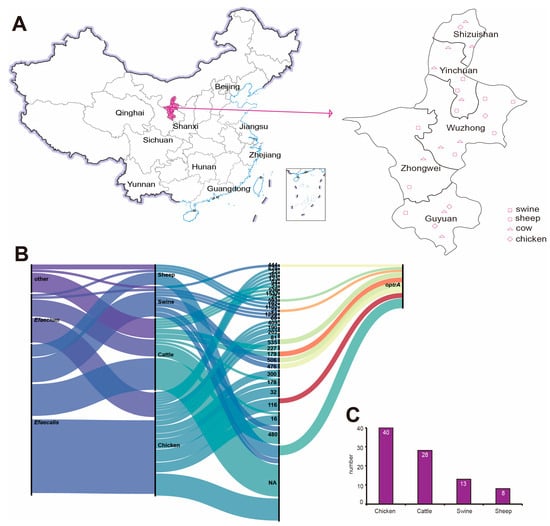
Figure 1
Open AccessArticle
Diagnostic Stewardship Trends and Antimicrobial Resistance Profiles of Bacteria Isolated in Zambia: A Five-Year Retrospective Study (2020–2024)
by
Joseph Yamweka Chizimu, Aubrey Chichonyi Kalungia, Steward Mudenda, Zoran Muhimba, Chileshe Lukwesa, Webrod Mufwambi, Amon Siame, Kelvin Mwangilwa, Priscilla Gardner, Jimmy Hangoma, Victor Daka, Chikwanda Chileshe, Ntombi B. Mudenda, Maisa Kasanga, Misheck Shawa, Herman Chambaro, Duncan Chanda, Taona Sinyawa, Bertha Chibwe, Kaunda Kaunda, Kaunda Yamba, O-Tipo Shikanga, Freddie Masaninga, Mpela Chibi, Sandra Diana Mwadetsa, Doreen Mainza Shempela, Mwendalubi Albert Hadunka, Samson Mukale, Andrew Bambala, Malambo Mutila, Loveness Sakalimbwe, Fred Mulako Simwinji, Geoffrey Mainda, Chie Nakajima, Ruth Nakazwe, Fusya Goma, Nyambe Sinyange, Yasuhiko Suzuki, John Bwalya Muma and Roma Chilengiadd
Show full author list
remove
Hide full author list
Antibiotics 2025, 14(11), 1136; https://doi.org/10.3390/antibiotics14111136 - 10 Nov 2025
Abstract
Background/Objectives: The right diagnostic tests, for the right patient, at the right time, are key to optimising antimicrobial use (AMU) and preventing antimicrobial resistance (AMR). This study evaluated diagnostic stewardship trends and AMR patterns in Zambian surveillance sentinel sites from 2020 to 2024.
[...] Read more.
Background/Objectives: The right diagnostic tests, for the right patient, at the right time, are key to optimising antimicrobial use (AMU) and preventing antimicrobial resistance (AMR). This study evaluated diagnostic stewardship trends and AMR patterns in Zambian surveillance sentinel sites from 2020 to 2024. Methods: This descriptive, retrospective study analysed routine laboratory data from January 2020 to December 2024 at seven designated AMR surveillance sentinel sites across Zambia. Data on clinical specimens submitted for antimicrobial susceptibility testing were extracted from WHONET and analysed by year, specimen type, and antimicrobial susceptibility profile. Results: A total of 184,788 bacteriology specimens were processed over five years. Urine was the most frequently collected specimen, peaking above 20,000 in 2024. Escherichia coli was the most commonly isolated organism among 15 priority pathogens, comprising 25.9% of the 30,013 isolates. Though a statistically significant increasing trend in total organism isolations was observed annually, only Shigella sp. demonstrated a substantial increase in non-susceptibility to azithromycin (p = 0.027). High resistance was observed with doxycycline, azithromycin, clindamycin, trimethoprim/sulfamethoxazole, ciprofloxacin, and rifampicin, exhibiting resistance ranging from 50% to 80%. Critical AMR alerts included 65% for Vancomycin-Resistant Enterococcus (VRE), 72% for linezolid, and 44% for carbapenems, and possible ESBL-producing Enterobacterales showing the highest overall resistance at 35%, across sentinel sites. Conclusions: Zambia faces a concerning and significant increase in AMR, with high resistance prevalence across commonly used antibiotics. Critical resistance alerts for VRE, linezolid, carbapenems, and possible ESBL-producing Enterobacterales underscore an urgent need for robust antimicrobial stewardship and continuous diagnostic surveillance.
Full article
(This article belongs to the Special Issue Antibiotic Resistance: From the Bench to Patients, 2nd Edition)
►▼
Show Figures

Figure 1
Open AccessArticle
Antibiotic Resistance in Urinary Pathogens Among Kidney Transplant Recipients: A Persistent Threat
by
Büşra Çalışır, Abdullah İbrahim Çalışır, Oktay Rodoplu, Abdulmecit Yıldız, Alparslan Ersoy and Cüneyt Özakın
Antibiotics 2025, 14(11), 1135; https://doi.org/10.3390/antibiotics14111135 - 10 Nov 2025
Abstract
Background: Urinary tract infections (UTIs) are the most common infections after kidney transplantation and significantly affect patient outcomes. In these immunosuppressed patients, antibiotic resistance is of particular concern due to recurrent infections and limited treatment options. The aim of this study was to
[...] Read more.
Background: Urinary tract infections (UTIs) are the most common infections after kidney transplantation and significantly affect patient outcomes. In these immunosuppressed patients, antibiotic resistance is of particular concern due to recurrent infections and limited treatment options. The aim of this study was to evaluate the distribution of microorganisms isolated from urine cultures of kidney transplant patients and to assess their antimicrobial susceptibility patterns. Methods: This retrospective study included all adult kidney transplant recipients with positive urine cultures during 2023–2024. Microorganisms were identified using matrix-assisted laser desorption ionization time-of-flight mass spectrometry (MALDI-TOF MS), and antimicrobial susceptibility testing was performed with the Phoenix System according to European Committee on Antimicrobial Susceptibility Testing (EUCAST) guidelines. Results: A total of 363 urine samples from 123 patients (85% female) were analyzed. E. coli (49%) and Klebsiella spp. (24%) were the predominant uropathogens. High resistance rates to ciprofloxacin and trimethoprim–sulfamethoxazole (TMP–SMX) were observed in both species, while carbapenem resistance remained low. Elevated resistance to multiple antibiotics was also detected among Pseudomonas aeruginosa and Acinetobacter spp., highlighting the importance of continued microbiological surveillance in this population. Conclusions: Gram-negative bacteria were the predominant pathogens causing UTIs in kidney transplant recipients. The high resistance rates to ciprofloxacin and TMP–SMX emphasize the need for local antimicrobial surveillance and individualized empirical therapy. Systematic and ongoing monitoring of resistance patterns is essential to optimize infection management in this vulnerable patient group.
Full article
(This article belongs to the Special Issue Antibiotic Surveillance and Rational Use in Special Populations: Enhancing Stewardship for Vulnerable Groups)
►▼
Show Figures

Figure 1
Open AccessReview
Phage Therapy for Acinetobacter baumannii Infections: A Review on Advances in Classification, Applications, and Translational Roadblocks
by
Yilin Wang, Liuyan Li, Yuqi Liang, Kehan Xu, Ying Ye and Maozhang He
Antibiotics 2025, 14(11), 1134; https://doi.org/10.3390/antibiotics14111134 - 8 Nov 2025
Abstract
The global spread of carbapenem-resistant Acinetobacter baumannii (CRAB) poses a severe public health threat, driving growing interest in phage-based precision antibacterial strategies. This systematic review synthesizes recent advances in the field of A. baumannii phage. Modern taxonomy, based on whole-genome phylogeny, has reclassified
[...] Read more.
The global spread of carbapenem-resistant Acinetobacter baumannii (CRAB) poses a severe public health threat, driving growing interest in phage-based precision antibacterial strategies. This systematic review synthesizes recent advances in the field of A. baumannii phage. Modern taxonomy, based on whole-genome phylogeny, has reclassified the majority of A. baumannii phages into the class Caudoviricetes, revealing distinct evolutionary clades that correlate with host tropism and biological properties, superseding the traditional morphological families (Myoviridae, Siphoviridae, Podoviridae). To overcome limitations of natural phage therapy, such as narrow host range, cocktail therapies (ex vivo resistance mutation rates < 5%) and phage-antibiotic synergism (enabling antibiotic efficacy at 1/4 minimum inhibitory concentration) have significantly enhanced antibacterial efficacy. Preclinical models demonstrate that phage therapy efficiently clears pathogens in pneumonia models and promotes the healing of burn wounds and diabetic ulcers via immunomodulatory mechanisms. Technical optimizations include nebulized inhalation delivery achieving 42% alveolar deposition, and thermosensitive hydrogels enabling sustained release over 72 h. Genetic engineering approaches, such as host range expansion through tail fiber recombination and CRISPR/Cas-mediated elimination of lysogeny, show promise. However, the genetic stability of engineered phages requires further validation. Current challenges remain, including limited host spectrum, the absence of clinical translation standards, and lagging regulatory frameworks. Future efforts must integrate metagenomic mining and synthetic biology strategies to establish a precision medicine framework encompassing resistance monitoring and personalized phage formulation, offering innovative solutions against CRAB infections.
Full article
(This article belongs to the Special Issue Antibiotic Resistance in Hospital-Acquired Infections)
►▼
Show Figures

Figure 1
Open AccessArticle
Novel Isolate of Halobacteriovorax Capable of Killing Multi-Drug-Resistant Escherichia coli and Salmonella
by
Stefania Di Lullo, Silvia Pieralisi, Giulia Talevi, Gabriele Angelico, Elena Rocchegiani, Francesca Leoni, Maira Napoleoni, Diego Maiolatesi, Francesca Barchiesi, Sara Nardi, Annalisa Petruzzelli, Claudia Gabucci, Angela Conti, Gianluigi Cardinali and Donatella Ottaviani
Antibiotics 2025, 14(11), 1133; https://doi.org/10.3390/antibiotics14111133 - 8 Nov 2025
Abstract
Background/Objectives: Due to the rising problem of antimicrobial resistance, there is increasing attention in the scientific community towards alternative approaches to combat Antimicrobial-Resistant (AMR) pathogens that do not involve the use of antibiotics. In this regard, the European Medicines Agency (EMA) and the
[...] Read more.
Background/Objectives: Due to the rising problem of antimicrobial resistance, there is increasing attention in the scientific community towards alternative approaches to combat Antimicrobial-Resistant (AMR) pathogens that do not involve the use of antibiotics. In this regard, the European Medicines Agency (EMA) and the European Food Safety Authority (EFSA) have promoted experimentation with predatory bacteria to fight antibiotic resistance. With the aim of identifying predatory bacteria suitable for the control of antibiotic-resistant bacteria, in this work we isolated a strain of Halobacteriovorax from an estuarine aquatic environment using a CTX-M-producing E. coli strain as prey and characterized it with respect to optimal physico-chemical parameters for growth and predation. Furthermore, we studied its predatory capacity against other E. coli strains and Multi-Drug-Resistant (MDR) Salmonella. Finally, we conducted challenge experiments to evaluate the growth of predator and prey over time. Methods: The Halobacteriovorax strain, designated HE7, was identified by 16S rRNA analysis. To isolate Halobacteriovorax and to evaluate its predatory ability towards different preys, the double-layer agar plating technique was applied. Results: HE7 showed in vitro predatory activity against all MDR strains of E. coli and Salmonella tested. In the 107 predator/103 prey and 107 predator/107 prey challenges, HE7 after 6 h achieved the total killing and a reduction of about 6 logs in the prey, respectively, maintaining this effect for up to 24 h. Conclusions: The results of this study highlight that HE7, but more generally Halobacteriovorax, could find application both alone and in an integrated context of antimicrobial strategies as an alternative to antibiotics.
Full article
(This article belongs to the Special Issue Antibiotic Residues, Antimicrobial Resistance and Intervention Strategies of Foodborne Pathogens, 2nd Edition)
►▼
Show Figures

Figure 1
Open AccessArticle
Changing Bacterial Profiles and Antibiotic Susceptibility Patterns in Spontaneous Ascites Infection: A Shift in Empiric Combination Antibiotic Therapy?
by
Ceren Kaplankıran and Ender Serin
Antibiotics 2025, 14(11), 1132; https://doi.org/10.3390/antibiotics14111132 - 8 Nov 2025
Abstract
►▼
Show Figures
Background/Objectives: This study aimed to determine bacteria that grow in spontaneous ascites infection and their antibiotic susceptibility. Materials and Methods: A total of 291 cases of cirrhosis-related ascites were retrospectively analyzed between January 2007 and September 2015. Simple ascites, spontaneous ascites infection, spontaneous
[...] Read more.
Background/Objectives: This study aimed to determine bacteria that grow in spontaneous ascites infection and their antibiotic susceptibility. Materials and Methods: A total of 291 cases of cirrhosis-related ascites were retrospectively analyzed between January 2007 and September 2015. Simple ascites, spontaneous ascites infection, spontaneous bacterial peritonitis, and culture results were recorded. Due to increasing antibiotic resistance, theoretically appropriate antibiotics were paired, and their susceptibility was evaluated in order to review our empirical antibiotic choices and evaluate new empirical treatment options. Results: In all cultures, 48.1% were Gram-positive cocci and 50.6% were Gram-negative bacilli. Multidrug-resistant bacteria grew in 16 cultures (22.2%). The most common bacterium was Escherichia coli, and the second most common bacteria were coagulase-negative staphylococci (CoNS). According to all culture data, the rate of antibiotic susceptibility was third- and fourth-generation cephalosporins between 76.4 and 68%, 68% for ampicillin-sulbactam, 81.8% for piperacillin-tazobactam, 66% for ciprofloxacin, 71% for levofloxacin, 30% for tetracycline, and 45% for penicillin. Beta-lactam group antibiotic susceptibility of CoNS was 25% for penicillin and 53% for ampicillin-sulbactam; 52% had methicillin resistance. The rate of resistance to quinolones was 35%. Multidrug resistance was detected in 40% of CoNS (eight cases). When theoretically appropriate antibiotics were paired, combination therapy increased the susceptibility rates. Conclusions: The increase in Gram-positive infections and resistance to other antibiotic groups indicates empirical antibiotic selection based on local microbial culture results and antibiotic susceptibility. Our results are crucial to allowing for more rational and successful use of antibiotics.
Full article
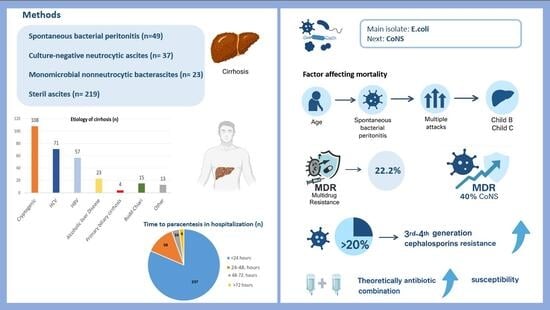
Graphical abstract
Open AccessSystematic Review
Prevalence and Resistance Profiles of Acinetobacter baumannii in ICU Patients in Saudi Arabia: A Systematic Review and Meta-Analysis
by
Alaa Alibrahim, Farooq Ahmed Wani, Ohoud Shafi Alruwaili, Sadeem Altaymani, Zaid Ali Alharbi, Sayyaf Alsubaiei, Saleh Aldhuwayhi, Mohammed Alsaeed and Mohammed Alibrahim
Antibiotics 2025, 14(11), 1131; https://doi.org/10.3390/antibiotics14111131 - 7 Nov 2025
Abstract
Background: Acinetobacter baumannii (A. baumannii), a critical nosocomial pathogen, poses a significant threat in intensive care units (ICUs) due to its multidrug-resistant (MDR) strains. This study systematically reviews and performs a meta-analysis on the prevalence and antibiotic resistance profiles of
[...] Read more.
Background: Acinetobacter baumannii (A. baumannii), a critical nosocomial pathogen, poses a significant threat in intensive care units (ICUs) due to its multidrug-resistant (MDR) strains. This study systematically reviews and performs a meta-analysis on the prevalence and antibiotic resistance profiles of MDR A baumannii (MDR-A. baumannii) in ICU patients in Saudi Arabia. Methods: A comprehensive search in PubMed, Saudi Digital Library, Scopus, and Web of Science, focusing on studies from January 2014 to September 2025, was performed. The present study followed the reporting guidelines of Preferred Reporting Items for Systematic reviews and Meta-Analyses (PRISMA-2020). Data on study characteristics, sample sizes, patient demographics, prevalence of MDR-AB, and antibiotic resistance profiles were extracted and analyzed. Quality assessment was conducted using the Joanna Briggs Institute. Results: The prevalence of MDR-AB in ICU patients varied significantly across studies, with retrospective studies reporting rates from 3.37% to 69% and prospective studies ranging from 3.9% to 72.73%. Colistin remained highly effective, showing 100% susceptibility in some studies. Meanwhile, resistance to carbapenems like imipenem and meropenem often exceeds 50%. Additional antibiotics with notable resistance included gentamicin, tigecycline, ampicillin/sulbactam, trimethoprim-sulfamethoxazole, ceftazidime, piperacillin/tazobactam, and third-generation cephalosporins. Mechanisms of resistance frequently involved OXA-type carbapenemases, particularly OXA-23. While OXA-23 was the most frequently detected carbapenemase, recent genomic data have also revealed the presence of metallo-β-lactamases, such as IMP-type genes, in ICU isolates. Conclusions: MDR-A. baumannii poses a substantial challenge in Saudi Arabian ICUs, with high prevalence and significant resistance to commonly used antibiotics. The results highlight the critical need for continuous monitoring, cautious antibiotic stewardship, and strict infection control methods to manage and lessen the effects of MDR-AB in ICUs.
Full article
(This article belongs to the Section Antibiotics Use and Antimicrobial Stewardship)
►▼
Show Figures

Figure 1
Open AccessSystematic Review
Long-Term Therapy with Long-Acting Lipoglycopeptide Antibiotics in the Treatment of Cardiovascular Prosthetic Infections: A Systematic Review
by
Francesca Gavaruzzi, Guido Granata, Alessandro Capone, Pierangelo Chinello and Stefania Cicalini
Antibiotics 2025, 14(11), 1130; https://doi.org/10.3390/antibiotics14111130 - 7 Nov 2025
Abstract
►▼
Show Figures
Background: Dalbavancin and oritavancin are long-acting lipoglycopeptides increasingly used off-label for a variety of Gram-positive infections. While their efficacy has been described in osteomyelitis, bacteremia, and infective endocarditis, evidence specifically addressing cardiovascular prosthetic infections such as prosthetic valve endocarditis (PVE), cardiac implantable
[...] Read more.
Background: Dalbavancin and oritavancin are long-acting lipoglycopeptides increasingly used off-label for a variety of Gram-positive infections. While their efficacy has been described in osteomyelitis, bacteremia, and infective endocarditis, evidence specifically addressing cardiovascular prosthetic infections such as prosthetic valve endocarditis (PVE), cardiac implantable electronic device (CIED) infections, left ventricular assist device infections (LVAD), and prosthetic vascular graft infections (PVGI) remains limited. These conditions are particularly challenging due to biofilm formation, difficulties in achieving surgical source control, and the frequent need for prolonged or suppressive therapy. Objectives: This systematic review aimed to summarize the available literature on the use of dalbavancin and oritavancin in cardiovascular prosthetic infections, with a focus on therapeutic strategies, clinical outcomes, and safety. Methods: We performed a systematic search of PubMed, Embase, Scopus, and Cochrane Library up to 24 June 2025 in accordance with PRISMA guidelines. Eligible studies included adults treated with dalbavancin or oritavancin for cardiovascular prosthetic infections. Data on study characteristics, population demographics, causative pathogens, and microbiological profiles, antibiotic regimens, treatment duration, use of therapeutic drug monitoring (TDM), indication or non-indication for chronic suppressive therapy, adverse events, clinical outcomes, and clinical efficacy were extracted. Results: Twenty studies comprising 113 patients were identified, of whom 111 received dalbavancin and 2 oritavancin. The main infections were PVE, CIED, LVAD, and PVGI. Dalbavancin was most effective as consolidation therapy after surgery or device removal, with high cure rates. Prolonged regimens were used as bridging or in partially treated cases, sometimes supported by TDM or PET/CT. Chronic suppressive therapy, mainly for LVAD and PVGI infections, achieved variable outcomes with relapses in about one fifth of patients. Adverse events were infrequent and generally mild. Conclusions: The included studies were highly diverse, conducted in various settings and with different objectives. Eight of the twenty included studies were single case reports on dalbavancin and oritavancin, highlighting the predominance of individual case descriptions in the available literature. Long-acting lipoglycopeptides may represent a valuable option for cardiovascular prosthetic infections. Their role appears most favorable as consolidation after adequate source control, while chronic suppressive use showed heterogeneous outcomes. This systematic review was registered on Open Science Framework. This work was supported by grants from the Italian Ministry of Health through Ricerca Corrente, Linea 3, Progetto 3.
Full article

Figure 1
Open AccessArticle
Anticandidal Activity and Low Cytotoxicity of Modified Analogues of the Tobacco Defensin NaD1
by
Olga V. Shevchenko, Ivan V. Bogdanov, Serafima I. Fateeva, Daria N. Melnikova, Anastasia A. Ignatova, Ilia Y. Toropygin, Tatiana V. Ovchinnikova and Ekaterina I. Finkina
Antibiotics 2025, 14(11), 1129; https://doi.org/10.3390/antibiotics14111129 - 7 Nov 2025
Abstract
Background/Objectives: The growing resistance development among fungi, including those of Candida species, poses significant challenges to public health, emphasizing the need for the implementation of innovative therapeutic approaches. The tobacco defensin NaD1 exhibits a pronounced activity against C. albicans, but its relatively
[...] Read more.
Background/Objectives: The growing resistance development among fungi, including those of Candida species, poses significant challenges to public health, emphasizing the need for the implementation of innovative therapeutic approaches. The tobacco defensin NaD1 exhibits a pronounced activity against C. albicans, but its relatively high cytotoxicity toward mammalian cells limits its potential application. Here, we investigated anticandidal activity and cytotoxicity of four modified analogues of NaD1 (NaD1-1 T44R/K45R, NaD1-2 L38R, NaD1-3 K36R/L38R, NaD1-4 L38R/T44R/K45R). Methods: These peptides contained substitutions with arginine of some amino acid residues in the C-terminal region of NaD1 and in its L5 loop (S35KILRR40), responsible for the “cationic grip” and binding to phosphatidylinositol 4,5-bisphosphate (PIP4,5), one of the primary targets of tobacco defensin action. Results: We showed that the modified NaD1 analogues effectively inhibited the growth of C. albicans cells but had a less fungicidal action than NaD1. As compared to NaD1, its modified analogues differed in their sensitivity to the presence of various salts; antifungal activities of NaD1-3 and NaD1-4 were more tolerant to the presence of NaCl and CaCl2, respectively. All modified analogues except NaD1-1 did not exhibit hemolytic activity and showed significantly less cytotoxicity towards human immune and epithelial cells compared to NaD1. All modified analogues enhanced the permeability of PIP4,5-containing liposomes, although less effectively than NaD1. Differences in their properties were also demonstrated through experiments on oligomerization and zymosan binding. Conclusions: Thus, we proposed that the modified NaD1 analogues NaD1-2, NaD1-3, and NaD1-4 appear to be promising candidate antifungals. However, further in vitro and in vivo studies are required to evaluate their therapeutic potential against critical fungal pathogens.
Full article
(This article belongs to the Special Issue Antimicrobial Plant Peptides as Prototypes of New Antifungal Drugs)
►▼
Show Figures

Figure 1
Open AccessArticle
Epidemiological Situation of Antibiotic-Resistant Microorganisms Identified in Patients Hospitalised at the University Teaching Hospital in Bialystok, Poland, in the 2020–2023 Period
by
Monika Filipkowska, Magda Orzechowska, Mateusz Zarychta and Mateusz Cybulski
Antibiotics 2025, 14(11), 1128; https://doi.org/10.3390/antibiotics14111128 - 7 Nov 2025
Abstract
Introduction: Antimicrobial resistance constitutes one of the key challenges to public health. It is a particularly serious problem in the context of hospital-acquired infections (HAIs). By causing infections that are difficult to treat, multiple-drug-resistant bacteria in the hospital environment often require the use
[...] Read more.
Introduction: Antimicrobial resistance constitutes one of the key challenges to public health. It is a particularly serious problem in the context of hospital-acquired infections (HAIs). By causing infections that are difficult to treat, multiple-drug-resistant bacteria in the hospital environment often require the use of toxic and costly drugs and prolonged hospital stays, and they result in long-term health consequences for patients, including a high risk of death. This study aimed to assess the epidemiological situation of antibiotic-resistant microorganisms in patients hospitalised at the University Teaching Hospital in Bialystok, Poland, between 2020 and 2023. Methods: Data from epidemiological reports covering 15 alert pathogens, including MRSA, VRE, KPC (+), and ESBL (+), were analysed. Their prevalence was assessed in three groups of wards: intensive care, surgical, and non-surgical. Infection and microbiological testing rates were referenced to the number of hospitalisations and patient-days. Results: A total of 6066 cases of infections caused by resistant microorganisms were identified. The most frequently isolated pathogen was Enterococcus faecium VRE, peaking in 2022 (11.43 per 1000 patients). A marked increase in Klebsiella spp. KPC (+) and Enterobacter spp. ESBL (+) was observed, particularly in the 2021–2022 period. Intensive care units showed the highest infection rate (30–36 per 1000 patient-days). In the 2022–2023 period, infections detected within <72 h of admission predominated, which may indicate prior patient colonisation or intensified screening. Conclusions: The rise in infections caused by antibiotic-resistant bacteria requires a high level of microbiological surveillance to be maintained, especially in intensive care units, and preventive measures at hospital admission to be strengthened.
Full article
(This article belongs to the Special Issue Antibiotic Resistance in Hospital-Acquired Infections)
►▼
Show Figures

Figure 1
Open AccessReview
Antibiotics for Intra-Abdominal Infections: When, Which, How and How Long?
by
Massimo Sartelli, Miriam Palmieri and Francesco M. Labricciosa
Antibiotics 2025, 14(11), 1127; https://doi.org/10.3390/antibiotics14111127 - 7 Nov 2025
Abstract
Intra-abdominal infections (IAIs) remain among the most challenging problems in surgical clinical practice. They range from uncomplicated appendicitis to life-threatening peritonitis, demanding rapid diagnosis, timely source control, and appropriate antibiotic therapy. Antibiotics are crucial to manage patients with complicated IAIs. Antibiotics should always
[...] Read more.
Intra-abdominal infections (IAIs) remain among the most challenging problems in surgical clinical practice. They range from uncomplicated appendicitis to life-threatening peritonitis, demanding rapid diagnosis, timely source control, and appropriate antibiotic therapy. Antibiotics are crucial to manage patients with complicated IAIs. Antibiotics should always be prescribed appropriately, ensuring the correct spectrum, timing, duration, and dosage. Appropriate prescribing within hospitals enhances treatment success and patient safety, while also reducing the risk of opportunistic infections such as Clostridioides difficile and lowering the likelihood of selecting resistant pathogens. Over recent decades, antimicrobial resistance has escalated into a worldwide public health threat. The rapid rise in multidrug-resistant organisms, especially Gram-negative bacteria, has created a pressing global concern. The objective of this narrative review is to describe (a) when antibiotics should be used in patients with IAIs; (b) which antibiotics should be selected in patients with IAIs; (c) how they should be managed in patients with IAIs; and (d) how long they should be administered in patients with IAIs.
Full article
(This article belongs to the Special Issue Antibiotic Utilization and Resistance Patterns in Perioperative and Surgical Settings)
Open AccessArticle
Antimicrobial Consumption and Utilisation in Zambia: Results from the Analysis of National Data for the Human and Animal Health Sectors
by
Steward Mudenda, Joseph Yamweka Chizimu, Victor Daka, Maisa Kasanga, Webrod Mufwambi, Kelvin Mwangilwa, Jimmy Hangoma, Priscilla Gardner, Chikwanda Chileshe, Ntombi B. Mudenda, Taona Sinyawa, Amon Siame, Mwendalubi Hadunka, Fred Mulako Simwinji, Kaunda Kaunda, Mpela Chibi, Zoran Muhimba, Elimas Jere, Makomani Siyanga, Peter Lisulo, Freddie Masaninga, Samson Mukale, Andrew Bambala, Misheck Shawa, Charles Chileshe, Bertha Chibwe, Mercy Mukuma, Bruno S. J. Phiri, Geoffrey Mainda, Yasuhiko Suzuki, Fusya Goma, John Bwalya Muma and Roma Chilengiadd
Show full author list
remove
Hide full author list
Antibiotics 2025, 14(11), 1126; https://doi.org/10.3390/antibiotics14111126 - 7 Nov 2025
Abstract
Background/Objectives: Antimicrobial Resistance (AMR) remains a growing public health threat, underscoring the need for robust surveillance of Antimicrobial Consumption (AMC) and Antimicrobial Use (AMU). This study analysed AMC and AMU trends in Zambia’s human and animal health sectors, identifying priority areas for antimicrobial
[...] Read more.
Background/Objectives: Antimicrobial Resistance (AMR) remains a growing public health threat, underscoring the need for robust surveillance of Antimicrobial Consumption (AMC) and Antimicrobial Use (AMU). This study analysed AMC and AMU trends in Zambia’s human and animal health sectors, identifying priority areas for antimicrobial stewardship (AMS) under a One Health framework. Methods: A retrospective study was conducted in February 2025, utilising data from 2018 to 2023. Sources of data included the Zambia Medicines Regulatory Authority (ZAMRA) and the WOAH Animal Antimicrobial Use (ANIMUSE) Global Database platform. AMC was analysed using the WHO Global Antimicrobial Resistance and Use Surveillance System (GLASS) methodology. Antimicrobials were classified using the WHO Anatomical Therapeutic Chemical (ATC) system, and consumption was measured in Defined Daily Doses (DDDs) per 1000 inhabitants per day (DID). Antibiotics were further categorised using the WHO Access, Watch, and Reserve (AwaRe) classification. Data analysis was performed using IBM SPPS version 25.0. Results: In the human health sector, oral antibiotics accounted for 88% of total consumption. Penicillins (33%), cephalosporins (19.2%), and macrolides (12.4%) were the most consumed classes. In 2023, 98,651,882.42 DDDs per 1000 inhabitants/day were recorded, with amoxicillin, ceftriaxone, and sulfamethoxazole/trimethoprim leading as the most consumed antibiotics. According to the consumption of antibiotics by the WHO AwaRe classification, 47% were Access, 40% Watch, and 3% Reserve group antibiotics. In animal health, tetracyclines dominated (63%), followed by sulphonamides (26%) and penicillins (11%). AMU in animal health peaked in 2023. Conclusions: This study found high AMC and AMU, especially Watch-group antibiotics and tetracyclines, highlighting the need for strengthened antimicrobial stewardship, regulatory oversight, and integrated One Health surveillance to mitigate AMR risks in Zambia.
Full article
(This article belongs to the Special Issue The One Health Action Plan Against Antimicrobial Resistance)
►▼
Show Figures

Figure 1
Open AccessArticle
Impact of Multidisciplinary-Led Implementation of Antimicrobial Stewardship Programs in Zambia: Findings and Implications
by
Joseph Yamweka Chizimu, Steward Mudenda, Victor Daka, Webrod Mufwambi, Zoran Muhimba, Kaunda Yamba, Misheck Shawa, Kelvin Mwangilwa, Jimmy Hangoma, Sombo Fwoloshi, Amon Siame, Kaunda Kaunda, Andrew Bambala, Kenneth Kapolowe, Priscilla Nkonde Gardner, Duncan Chanda, Shempela Doreen, Charles Chileshe, Paul Simujayang`ombe, Ntombi B. Mudenda, Loveness Sakalimbwe, Aubrey C. Kalungia, Chikwanda Chileshe, Taona Sinyawa, Maisa Kasanga, Raphael Chanda, Samson Mukale, Shikanga O-Tipo, Evelyn Wesangula, Cephas Sialubanje, Adrian Muwonge, Fred Simwinji, Chie Nakajima, Freddie Masaninga, Fusya Goma, Nyambe Sinyange, Yasuhiko Suzuki, John Bwalya Muma and Roma Chilengiadd
Show full author list
remove
Hide full author list
Antibiotics 2025, 14(11), 1125; https://doi.org/10.3390/antibiotics14111125 - 7 Nov 2025
Abstract
►▼
Show Figures
Background/Objectives: Antimicrobial resistance (AMR) is a critical global health threat, with sub-Saharan Africa disproportionately affected. Antimicrobial stewardship (AMS) programs are essential in combating AMR; however, data on their implementation in resource-limited settings like Zambia remain scarce. This study assessed the post-implementation status
[...] Read more.
Background/Objectives: Antimicrobial resistance (AMR) is a critical global health threat, with sub-Saharan Africa disproportionately affected. Antimicrobial stewardship (AMS) programs are essential in combating AMR; however, data on their implementation in resource-limited settings like Zambia remain scarce. This study assessed the post-implementation status of World Health Organization (WHO) AMS core elements in selected public hospitals in Zambia. Methods: A cross-sectional pre- and post-intervention survey was conducted in 11 public hospitals across Zambia’s 10 provinces. Baseline (pre-implementation) and 12-month follow-up (post-implementation) assessments were carried out using the WHO-adapted Periodic National and Healthcare Facility Assessment Tool. The six AMS core elements evaluated included leadership, accountability, AMS actions, education, monitoring, and feedback. Results: The average AMS program score increased from 59% at pre-implementation to 81% at post-implementation. Significant improvements were observed in education and training (+36%) and accountability (+31%). While leadership and monitoring also showed positive trends, gaps persisted in AMS actions (63%) and feedback/reporting mechanisms (68%). Drug and Therapeutics Committee (DTC) functionality improved by 23%, with 90% of facilities now holding regular DTC meetings. Implementation of AMS actions, such as ward rounds, rose from 0% to 73%. Challenges remained in clinical audit feedback, resource mobilization, and prescribing optimization. Variability across facilities highlighted differences in leadership, resources, and technical capacity. Conclusions: AMS implementation in Zambia improved substantially across key domains. However, sustained leadership, adequate financing, and continuous capacity-building are needed to address persistent gaps and ensure long-term success in mitigating AMR.
Full article

Figure 1

Journal Menu
► ▼ Journal Menu-
- Antibiotics Home
- Aims & Scope
- Editorial Board
- Reviewer Board
- Topical Advisory Panel
- Instructions for Authors
- Special Issues
- Topics
- Sections & Collections
- Article Processing Charge
- Indexing & Archiving
- Editor’s Choice Articles
- Most Cited & Viewed
- Journal Statistics
- Journal History
- Journal Awards
- Society Collaborations
- Conferences
- Editorial Office
Journal Browser
► ▼ Journal BrowserHighly Accessed Articles
Latest Books
E-Mail Alert
News
Topics
Topic in
Agriculture, Animals, Veterinary Sciences, Antibiotics, Zoonotic Diseases
Animal Diseases in Agricultural Production Systems: Their Veterinary, Zoonotic, and One Health Importance, 2nd Edition
Topic Editors: Ewa Tomaszewska, Beata Łebkowska-Wieruszewska, Tomasz Szponder, Joanna Wessely-SzponderDeadline: 31 March 2026
Topic in
Antibiotics, IJMS, Microbiology Research, Pharmaceuticals, Pharmaceutics, Nanomaterials, Microorganisms
Challenges and Future Prospects of Antibacterial Therapy, 2nd Edition
Topic Editors: Kwang-Sun Kim, Zehra EdisDeadline: 30 November 2026
Topic in
Biomolecules, IJMS, Micro, Molecules, Antibiotics, Nanomaterials, Microorganisms, JFB
Antimicrobial Agents and Nanomaterials—2nd Edition
Topic Editors: Vasco D. B. Bonifácio, Sandra PintoDeadline: 31 December 2026
Topic in
Antioxidants, Biology, Biomedicines, Microorganisms, JoF, IJMS, Stresses, Antibiotics
Microbial Redox Biology: From Stress Response to Biotechnology
Topic Editors: Michal Letek, Volker BehrendsDeadline: 1 March 2027

Conferences
Special Issues
Special Issue in
Antibiotics
Pathogenic Microorganisms and Antibiotic Therapy in Infectious Disease
Guest Editors: Angela Quirino, Grazia Pavia, Nadia MarascioDeadline: 15 November 2025
Special Issue in
Antibiotics
Antimicrobial Resistance in Aquaculture: Balancing Health and Sustainability
Guest Editor: Zhigang ZhouDeadline: 15 November 2025
Special Issue in
Antibiotics
New Natural Products as Candidates for the Discovery of Antimicrobial Drugs
Guest Editors: Maya Zaharieva, Hristo NajdenskiDeadline: 15 November 2025
Special Issue in
Antibiotics
The Battle Against Urinary Tract Infections: The Role of Antibiotics
Guest Editors: Pawel Miotla, Sara WawrysiukDeadline: 15 November 2025
Topical Collections
Topical Collection in
Antibiotics
Antibiotics in Ophthalmology Practice
Collection Editor: Sanjay Marasini
Topical Collection in
Antibiotics
Staphylococcus— Molecular Pathogenesis, Virulence Regulation and Antibiotics Resistance
Collection Editor: Ewa Szczuka
Topical Collection in
Antibiotics
Editorial Board Members' Collection Series: Structural Aspects of AMPs and Antimicrobials
Collection Editors: J. Michael Conlon, Marc Maresca, Bong-Jin Lee, Aurélie Tasiemski
Topical Collection in
Antibiotics
Synthetic and Natural Products-Based Antimicrobial and Antiparasitic Agents
Collection Editor: Antonio Eduardo Miller Crotti



